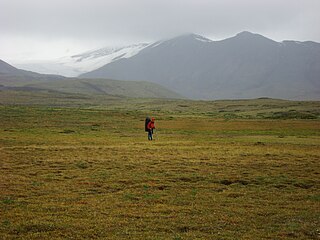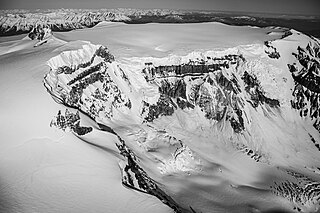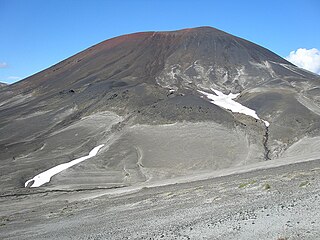Mount Edziza is a mountain in northwestern British Columbia, Canada.
Edziza can also refer to:
Mount Edziza is a mountain in northwestern British Columbia, Canada.
Edziza can also refer to:

Mount Edziza Provincial Park is a provincial park in Cassiar Land District of northern British Columbia, Canada. It was established on 27 July 1972 to showcase the Mount Edziza volcanic complex and the surrounding Tahltan Highland.

Mount Edziza, known to the Tahltan people as Tenh Dẕetle, is a volcanic mountain in Cassiar Land District of northwestern British Columbia, Canada. It is located on the Big Raven Plateau of the Tahltan Highland which extends along the western side of the Stikine Plateau. Mount Edziza has an elevation of 2,786 metres and a topographic prominence of 1,750 metres, making it the highest point of the Mount Edziza volcanic complex and one of Canada's ultra-prominent peaks. However, it had an elevation of at least 3,396 metres before its formerly cone-shaped summit was likely destroyed by a violent, climactic eruption in the geologic past; its current flat summit contains an ice-filled, 2-kilometre-in diameter (1.2-mile) crater. The mountain contains several lava domes, cinder cones and lava fields on its flanks, as well as an ice cap that is characterized by several outlet glaciers stretching out to lower altitudes. All sides of Mount Edziza are drained by tributaries of Mess Creek and Kakiddi Creek which are situated within the Stikine River watershed.

The Spectrum Range, formerly gazetted as the Spectrum Mountains and the Rainbow Mountains, is a small mountain range in Cassiar Land District of northwestern British Columbia, Canada. Located at the southern end of the Tahltan Highland, it borders the Skeena Mountains in the east and the Boundary Ranges of the Coast Mountains in the west. The Spectrum Range is surrounded by the Arctic Lake Plateau in the southwest and the Kitsu Plateau in the northwest, both of which contain volcanic features such as cinder cones. It lies at the southern end of the Mount Edziza volcanic complex which includes the two neighbouring plateaus as well as Mount Edziza and the Big Raven Plateau to the north. The mountain range is drained on all sides by streams within the Stikine River watershed and, unlike Mount Edziza to the north, contains relatively small separate glaciers. Mount Edziza Provincial Park is the main protected area surrounding the Spectrum Range.
Williams Cone is a satellite cone of Mount Edziza, located 36 km (22 mi) east of Telegraph Creek. It lies just off the northern edge of the Tencho Icefield and is one of the many postglacial cinder cones that lie on the Mount Edziza volcanic complex. Williams Cone last erupted about 1,350 years ago along with other nearby volcanoes, such as the well-preserved Eve Cone.
The Pyramid, also called Pyramid Dome, is a young lava dome on the northeast flank of Mount Edziza in British Columbia, Canada. It represents several different styles of volcanic activity of the Mount Edziza volcanic complex, part of the Northern Cordilleran Volcanic Province. Its latest eruption occurred during the Pleistocene epoch.
Coffee Crater is a well-preserved cinder cone south of Mount Edziza, British Columbia, Canada. It was formed during the Holocene period. It is within the Snowshoe lava field, part of the Mount Edziza volcanic complex.
Tsekone Ridge, also called Tsekone Peak and Black Knight Cone, is an isolated ridge on the Big Raven Plateau of the Tahltan Highland in northwestern British Columbia, Canada. It is located southeast of Telegraph Creek at the north side of Mount Edziza Provincial Park between Eve Cone and Mount Edziza.

Cocoa Crater is a cinder cone in the Stikine Country of northwestern British Columbia, Canada. It is located 38 km southeast of Telegraph Creek and 8 m (26 ft) southwest of Mount Edziza. Cocoa Crater is one of the 30 cinder cones around the Mount Edziza complex that formed in the year 700. The ash around Cocoa Crater is quite deep, its summit is a jet black color and its summit is red. It is quite a different color from the brown color of Coffee Crater, which is to the south of Cocoa Crater.
Ice Peak is the prominent south peak of Mount Edziza in northwestern British Columbia, Canada. It is the eroded remains of a stratovolcano predating the main edifice of Mount Edziza and contains a 2,500-metre-high (8,200-foot) summit which represents the western rim of a small caldera. The Ice Peak stratovolcano has been largely destroyed by glacial erosion but it was volcanically active during the Holocene. Ice Peak and the main mass of Mount Edziza are wholly known to the local Tahltan as Tenh Dẕetle which translates to Ice Mountain.

Nahta Cone is a small cinder cone in Cassiar Land District of northwestern British Columbia, Canada. It has an elevation of 1,670 metres and lies near the northern edge of the Arctic Lake Plateau, a glacially scored plateau of the Tahltan Highland which in turn extends along the western side of the Stikine Plateau. The cone is about 70 kilometres south-southeast of the community of Telegraph Creek and lies in the southwestern corner of Mount Edziza Provincial Park, one of the largest provincial parks in British Columbia.
Wetalth Ridge is an isolated ridge in northern British Columbia, Canada, located 74 km (46 mi) southwest of Tatogga and south of Telegraph Creek. It lies on the southwest side of Little Arctic Lake at the southwest corner of Mount Edziza Provincial Park.
Pillow Ridge is a ridge of the Tahltan Highland in northern British Columbia, Canada, located southeast of Telegraph Creek. It extends northwest from Mount Edziza in Mount Edziza Provincial Park.

Tennena Cone, alternatively Icebridge Cone, is a small volcanic cone in Cassiar Land District of northwestern British Columbia, Canada. It has an elevation of 2,390 metres and lies on the western flank of Ice Peak, the prominent south peak of Mount Edziza. The cone is almost completely surrounded by glacial ice of Mount Edziza's ice cap which covers an area of around 70 square kilometres. Tennena Cone is 200 metres high, 1,200 metres long and up to 600 metres wide, its symmetrical structure resembling a black pyramid. The cone and the surrounding area are in Mount Edziza Provincial Park which also includes the Spectrum Range to the south.

The Mount Edziza volcanic complex is a group of volcanoes and associated lava flows in northwestern British Columbia, Canada. Located on the Tahltan Highland, it is 40 kilometres southeast of Telegraph Creek and 85 kilometres southwest of Dease Lake. The complex encompasses a broad, steep-sided lava plateau that extends over 1,000 square kilometres. Its highest summit is 2,786 metres in elevation, making the MEVC the highest of four large complexes in an extensive north–south trending volcanic region. It is obscured by an ice cap characterized by several outlet glaciers that stretch out to lower altitudes.
Cartoona Peak is a volcanic peak at the westernmost end of Cartoona Ridge in northern British Columbia, Canada, located just southeast of Coffee Crater in Mount Edziza Provincial Park.
Tadeda Peak, also known unofficially as Tadeda Centre, is a volcanic peak in northern British Columbia, Canada, located just northeast of Raspberry Pass in Mount Edziza Provincial Park.
Sezill Volcano is a lava dome in Mount Edziza Provincial Park of northern British Columbia, Canada. It is thought to have formed and last erupted during the Miocene period. The volcano gets its name from being adjacent to Sezill Creek.
Klastline Cone is a cinder cone in northwestern British Columbia, Canada, located near Mount Edziza in Mount Edziza Provincial Park. It last erupted during the Pleistocene epoch.
Pharaoh Dome is a lava dome in northwestern British Columbia, Canada, located near Mount Edziza in Mount Edziza Provincial Park. It last erupted during the Pleistocene epoch.
Sphinx Dome is a lava dome in northwestern British Columbia, Canada, located near Mount Edziza in Mount Edziza Provincial Park. It last erupted during the Pleistocene epoch.